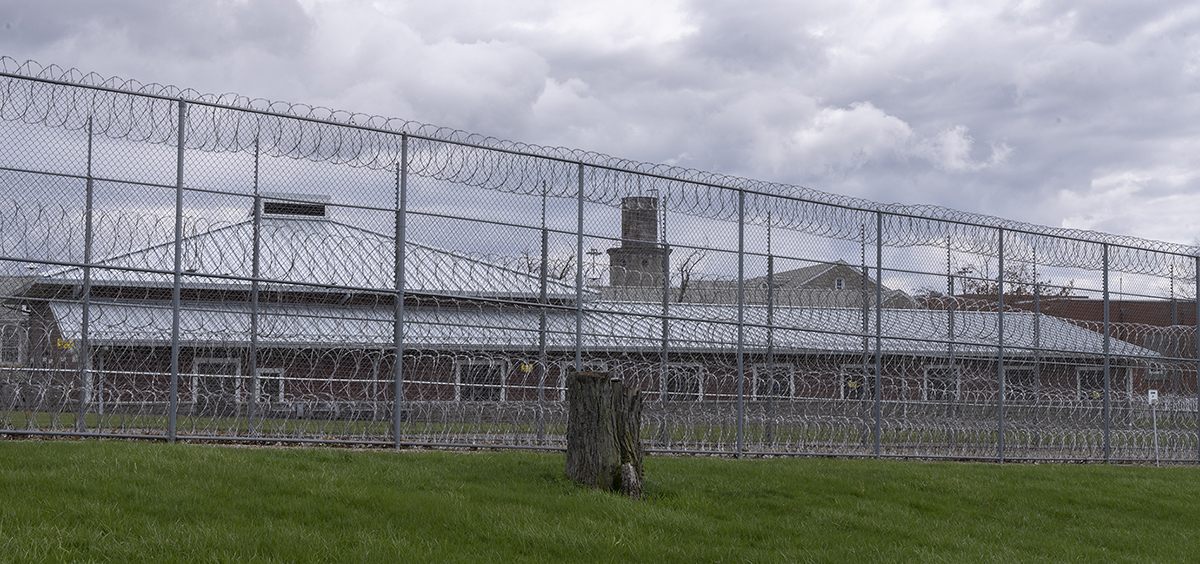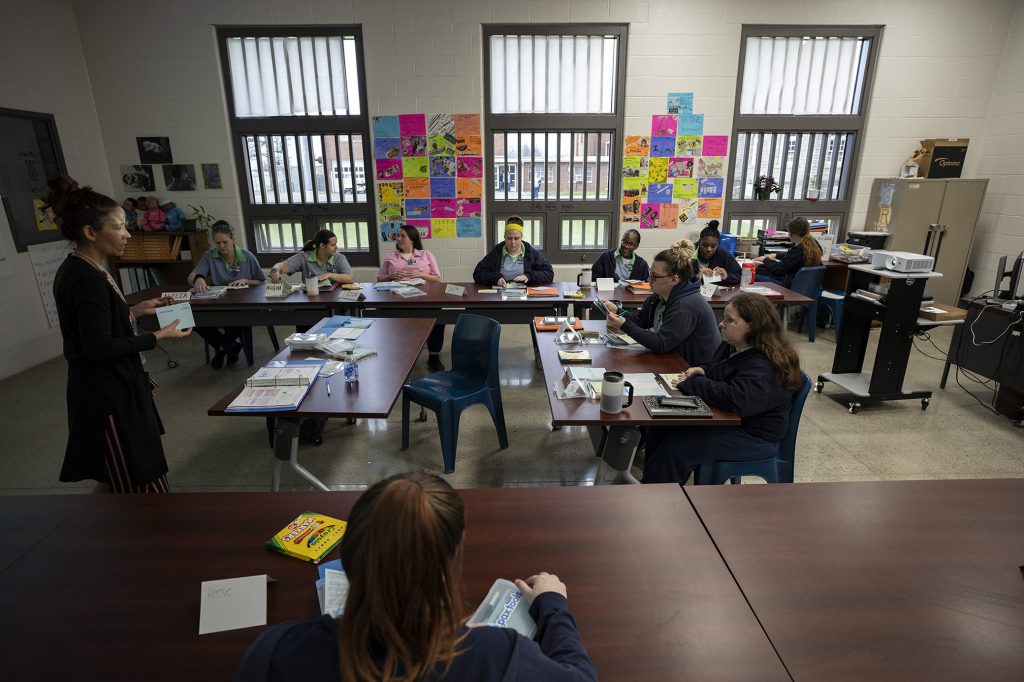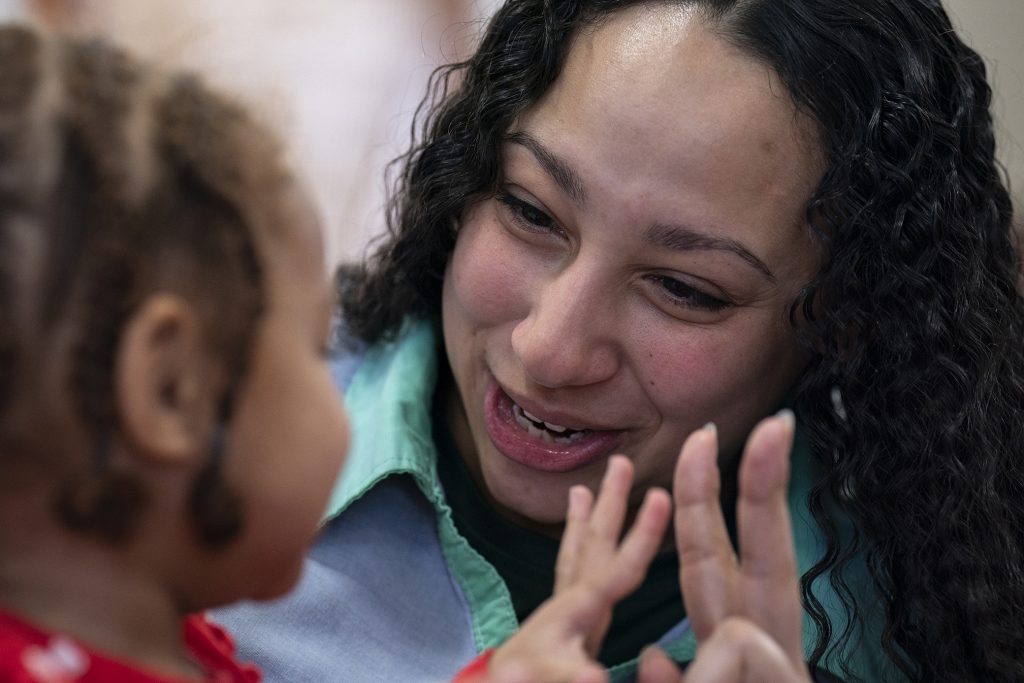News

Prison nurseries help incarcerated mothers bond, but options are limited
By: Kaitlin Thorne | Ohio Valley ReSource
Posted on:
MARYSVILLE, Ohio (OVR) – Kea’Londa Fuqua was 20 years old when she found out she was pregnant with her first child. A surprise pregnancy at a young age can feel overwhelming, but Fuqua had an additional stressor on her impending motherhood: a prison sentence.
She recalls being overwhelmed and uncertain about what would happen next.
“It was just one thing after another. It was a shock and I didn’t know what the future held for me and my baby. I didn’t know what to expect. I didn’t even know if I was coming to prison,” Fuqua said.
Fuqua was initially placed in the general population of the Ohio Reformatory for Women in Marysville, the only women’s prison in the state.
She remembers the extreme heat inside the general population building and the feeling of being surrounded by hundreds of people, some of whom hassled her for being pregnant. This was also during the height of the coronavirus pandemic.
“It was a hassle, it was exhausting, it was stressful. I came to prison in the middle of September, so it was very hot. It was just all a lot. I actually caught COVID,” Fuqua said. “It was scary.”
But when she was six months pregnant, Fuqua applied for the prison’s Achieving Baby Care Success program, which allows inmates to maintain custody of infants after they are born.

Fuqua says she has access to important opportunities and resources she wouldn’t otherwise get.
“I might be incarcerated but my son’s definitely not incarcerated,” Fuqua said.
Prison nursery programs find positive results
Studies show forming mother-child bonds early on is vital to development and happiness later in life.
Fuqua said getting into the nursery program unlocked something in her that as a first time mother, she thought she was missing.
“It just opens up that motherhood that I really didn’t think I had. I just expected that every day was going to be frustration. Now, every day I’m happy to wake up to his smile. I’m happy to have this one on one time with him,” Fuqua said.
But Fuqua is one of only a few pregnant inmates to have access to a prison nursery.
Across the country, there are only eight prison nursery programs currently operational. A prison nursery in Missouri was recently approved by the legislature and is projected to be open by 2025.
In West Virginia, the Keeping Infant Development Successful program at the Lakin Correctional Center can house up to five women and their babies at a time, though no one has been enrolled in the program since the beginning of the coronavirus pandemic.
According to Lakin Superintendent John Sallaz, 31 women have started the program, 25 have completed it, and of those, only four have reoffended and returned to prison.
“To us, that just speaks for itself, as far as how successful it is,” Sallaz said.
Women are one of the fastest growing demographics in U.S. prisons. In 2020, nearly 153,000 women were incarcerated, a 500% percent increase since 1980.
The federal government doesn’t keep detailed data on pregnancy in prisons because the vast majority of incarcerated women are housed in state prisons or county jails. Research from the Advocacy and Research on Reproductive Wellness of Incarcerated People suggests that around 58,000 pregnant people are sent to U.S. jails or prisons each year.
Dr. Carolyn Sufrin, an associate professor of gynecology and obstetrics at Johns Hopkins University, said that it’s up to each state to decide how pregnancy in prison is tracked, which can cause significant problems.
“If we don’t have data about how many pregnant people there are and the outcomes of those pregnancies then how do we know what kind of interventions need to be done in order to optimize the health and wellbeing of pregnant people and the infants they may give birth to,” Sufrin said.
The pregnant prison population is “systematically overlooked,” according to Sufrin. Because pregnancies are behind a prison wall, the outside world forgets about them. Meanwhile, inside the prison system, pregnant inmates are a smaller demographic and their needs aren’t always considered, Sufrin said.
“For the women who do meet eligibility criteria for these nursery programs, of course they’re going to have better outcomes,” she said. “They’re going to be the ones who likely have lower recidivism rates to begin with.
Alternative options emerge
Several states offer prison alternatives for pregnant inmates. In California and Texas, prison residential programs allow qualifying mothers and children to be together in a secure setting away from the prison with access to services that encourage the mother and child to bond.
Minnesota is one of the most progressive states when it comes to pregnancy in prison. The Minnesota Prison Doula Project allows incarcerated people to get services from trained doulas who help them manage pregnancies. In 2021, the state passed the Healthy Start Act, which allows pregnant mothers to serve their prison sentences in community-based alternatives like halfway houses or rehabilitation centers.
Community-based programs like rehabilitation centers can be an important alternative for pregnant people who end up in the criminal justice system for drug-related convictions. Over the past 35 years, drug related arrests have increased nearly 215% for women and just 35% increase among men.
Jackie McGranahan, a policy analyst for the American Civil Liberties Union of Kentucky, says treating substance use disorder is one of the best options for pregnant inmates.
“They are so much better prepared for success than someone who is simply incarcerated,” McGranahan said. “You are learning how to live, that recovery is possible for everyone, number one. And that the chance to become a parent isn’t a far off dream, it becomes a reality and you’re given the wrap-around services available to make that possible.”
While Kentucky doesn’t have a prison nursery or a prison residential program, it does have many rehabilitation centers as the state continues to struggle with the opioid crisis. But entry into the programs is largely up to local judges.
Pregnancy care in prison is different across the country
Since there is no nationwide standard of care for how pregnant people are treated in prisons, experiences vary widely across the country.
Some states still allow inmates to be shackled during pregnancy.
Ohio, Kentucky and West Virginia all restrict shackling pregnant inmates, but that doesn’t mean it’s a thing of the past. Kentucky still allows it in some cases, if the corrections officer deems it to be necessary. McGranahan says that allows the policy to be abused.
“Once you left it open at the discretion of the corrections officer…nothing was really changing,” she said.
Shackling pregnant inmates was prohibited in federal prisons by 2018’s First Step Act, but there is still a provision for the use of shackling when the prisoner is considered a flight risk or a threat to public safety.
There is also a patchwork of laws across the country over breastfeeding or pumping breast milk within prisons. A study of 22 state prison systems found that only eleven had policies supporting the practice of expressing milk despite the fact that not being able to pump or breastfeed can lead to painful breast engorgement.

“From being in prison they just think that a lot of times you’re lying if you say there’s something going on. They don’t really seem to trust your word because you’re looked at as an inmate,” Small said.
Small said she was fortunate to have few issues with her pregnancy, but recalls long wait times anytime she needed medical care.
Eventually she was accepted to the prison’s nursery program following the birth of her daughter. Small said she’s grateful for the opportunity.
“I feel blessed to be in this program. For the simple fact that I get to spend the first time of her life with her and I don’t have to send her home. That’s a blessing,” Small said.
Small’s earliest release date is June 2023. Kea’Londa Fuqua’s release date is February 2023, but she’s eligible for early release and hopes to get out earlier.
“I have a whole blueprint of what I’m going to do now. Other than when I was pregnant, now my son’s involved. Like he is 90% of my plans when I come home,” Fuqua said.

